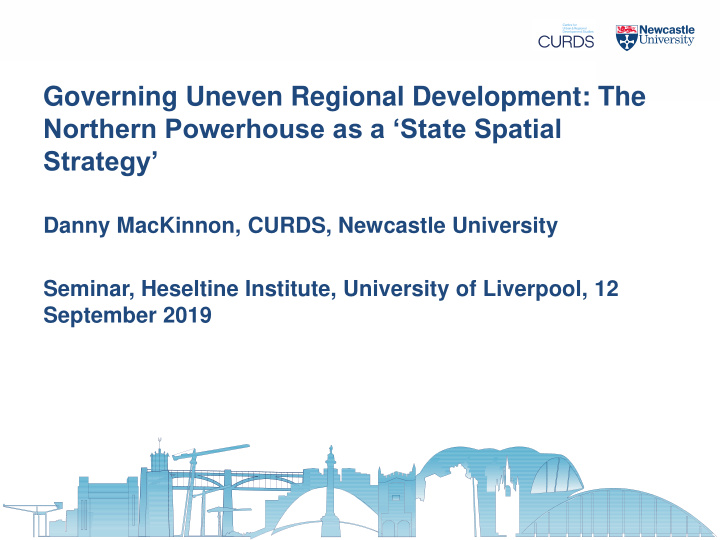



Governing Uneven Regional Development: The Northern Powerhouse as a ‘State Spatial Strategy’ Danny MacKinnon, CURDS, Newcastle University Seminar, Heseltine Institute, University of Liverpool, 12 September 2019
Introduction • NPh established by George Osborne in 2014 as latest initiative for spatially rebalancing the UK economy. • … if we can bring our northern cities closer together – not physically, or in some artificial political construct – but by providing modern transport connections, supporting great science and our universities here, giving more power and control to civic government; then we can create a northern powerhouse with the size, the population, the political and economic clout, to be as strong as any global city. (Osborne 2014).
Introduction • Theoretical and political analysis of the NPh as part of a broader state strategy for governing and managing uneven regional development in the UK • Adopt strategic — relational state theory (SRST) approach, 3 contributions • Sensitivity to particularities of state space. • Agency of key actors in harnessing powers of state and mobilising interests • Political capacity and coherence of state in pursing strategies over time. • Argues that the NPh represents a ‘state spatial strategy’ for the North of England, linked to the ‘state spatial project’ of English devolution.
Spatialising Strategic-Relational State Theory • Strategic-relational state theory (Jessop 1990; 2016) • From this perspective, the state has: • “no power; it is merely an institutional ensemble; it has only a set of institutional capacities and liabilities which mediate that power; the power of the state is the power of the social forces acting in and through the state” (Jessop, 1990, p. 269 -70). • State has no essential unity, but must be actively unified through specific ‘state projects’. • Supported by ‘hegemonic visions’ or projects. • Linked to accumulation strategy as specific economic growth model.
Spatialising Strategic-Relational State Theory • ‘New state spaces’ (Brenner 2004) Key parameters of state spatial organisation State spatial projects State spatial strategies Scalar dimension Centralisation versus Singularity versus decentralisation multiplicity Territorial dimension Standardisation versus Equalisation versus customisation concentration Adapted from Brenner (2004: 97) and Varro (2010: 1274).
Spatialising Strategic-Relational State Theory • Limitations of SRST • Underlying processes of state restructuring privileged over spatial particularities • Underplays questions of social and political agency • Continued sense of the state as a unified and coherent political and economic actor
Origins of Northern Powerhouse Concept • Agenda of regional rebalancing from 2010. • New economic geography / urban economics. • Northern core cites. • HS2, East-West links, Higgins Report 2014. • RSA City Growth Commission 2014. I think George’s own motivation started when he got booed at the Olympics… And he because he had become so much the face of austerity, he was trying to find something else. And this appeals to him. (Senior policy maker, September 2017.
NPh as a Regional Accumulation Strategy • Accumulation strategy • NPh Independent Economic Review
NPh as ‘State Spatial Strategy’ • Original vision of bringing the Northern cities closer together requires transport investment. • Establishment of Transport for the North and Northern Transport Strategy. • Northern Powerhouse Rail, funding commitment?
NPh as ‘State Spatial Strategy’ • Investment promotion. • Scale and international recognition • Led by national state and promotes spatial concentration
NPh as a Regional Hegemonic Vision • Hegemonic vision • Framed by broader spatial rebalancing discourse, but widening disparities, e.g. transport investment • Prominence in 2015 election, key part of Conservative political strategy • Mode of representation favoured business interests and civic leaders
NPh as a Regional Hegemonic Vision • But city-centric business agenda unable to engage wider public. • Reflected in ‘Leave’ vote outside core cities • Dismissal of Osborne but continued agency beyond state through Northern Powerhouse Partnership • Government attempted rebranding as ‘Northern Powerhouse 2.0’, based on a ‘whole North approach’, spatial equalisation
Devolution as ‘State Spatial Project’ • Devolution folded into NPh • Deal-based approach, customisation versus uniformity. North of Tyne • Spatially selective, city- regions. • NPh as ‘soft’ space of Tees Valley cross-regional collaboration between local political leaders. West Liverpool Yorkshire Sheffield City Region Greater Manchester
Conclusions • View NPh as ‘state spatial strategy’ to strengthen regional competitiveness of the north of England, linked to a ‘state spatial project’ of devolution. • Re-politicise SRST through a focus on the key political and economic actors working through the state. • Unable to sustain effective hegemony beyond 2016. • Fluctuating levels of state commitment over time. Periodic reaffirmations of support, but lack of institutional capacity and investment.
Recommend
More recommend